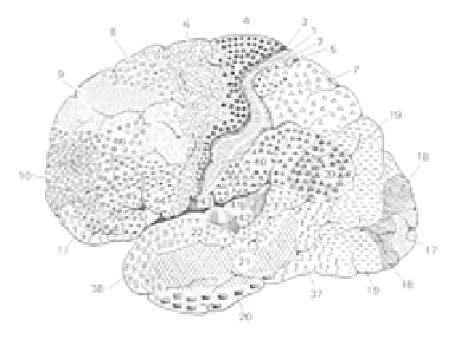Information Technology Reference
In-Depth Information
Inhibition and Attention
Because there is
inhibition
operating at all levels of
processing in the cortex as discussed in chapter 3, there
is a natural and pervasive limitation on the amount of
activation, and thus on the number of things that can be
simultaneously represented. This gives rise to the phe-
nomenon of
attention
, where some aspects of the sen-
sory input (or internal context) are ignored in favor of
attention
paid to others (see chapter 8 for more on this).
Although cognitive psychologists often view attention
as a somewhat discrete and separable mechanism, we
view it as an emergent property of constraint satisfac-
tion under the limits of inhibition (for similar ideas, see
Desimone & Duncan, 1995; Allport, 1989).
As we have seen, both the external environment and
the internal context can determine what is attended to
and what is ignored. Further, because all levels of
processing are constrained by inhibition, and all lev-
els mutually influence each other to varying degrees via
bidirectional connectivity, attentional effects that arise
at any level of abstraction can have important conse-
quences for processing at other levels. At a functional
level, attention is critical for ensuring some level of
co-
herence
of processing, so that representations at differ-
ent levels of processing are all focused on the same un-
derlying thing or set of things. This coherence effect
will be important for solving some of the problems dis-
cussed later.
Figure 7.3:
Four cortical lobes and associated functions.
Figure 7.4:
Brodmann's areas of the cortex, based on
anatomically visible differences in the structure of the cortical
layers in different cortical areas.
Reproduced from
Kandel
7.3
General Functions of the Cortical Lobes and
Subcortical Areas
et al. (1991).
Building on the basic principles and mechanisms sum-
marized above, we now turn to the functional special-
izations of different brain areas at a relatively large scale
of analysis. The emphasis is on the most cognitively
relevant brain areas, including the cortex, parts of the
limbic system, and other subcortical brain areas.
superior
dorsal
top
anterior
rostral
front
posterior
caudal
back
inferior
ventral
bottom
7.3.1
Cortex
The human cortex is organized into four
lobes
that con-
tain a number of specialized processing pathways and
higher-level association areas. The general nature of
these specialized functions is described next, illustrated
Figure 7.5:
Various terms used to refer to locations in the
brain.




Search WWH ::

Custom Search